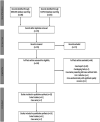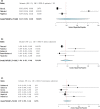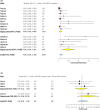Prevalence, clinical characteristics and outcomes of Guillain-Barré syndrome spectrum associated with COVID-19: A systematic review and meta-analysis
- PMID: 33837630
- PMCID: PMC8250909
- DOI: 10.1111/ene.14860
Prevalence, clinical characteristics and outcomes of Guillain-Barré syndrome spectrum associated with COVID-19: A systematic review and meta-analysis
Abstract
Background and purpose: Mounting evidence supports an association between Guillain-Barré syndrome spectrum (GBSs) and severe acute respiratory syndrome coronavirus 2 (SARS-CoV-2) infection. However, GBSs in the setting of coronavirus disease 2019 (COVID-19) remains poorly characterized, whilst GBSs prevalence amongst COVID-19 patients has not been previously systematically evaluated using a meta-analytical approach.
Methods: A systematic review and meta-analysis of observational cohort and case series studies reporting on the occurrence, clinical characteristics and outcomes of patients with COVID-19-associated GBSs was performed. A random-effects model was used to calculate pooled estimates and odds ratios (ORs) with corresponding 95% confidence intervals (CIs), compared to non-COVID-19, contemporary or historical GBSs patients.
Results: Eighteen eligible studies (11 cohorts, seven case series) were identified including a total of 136,746 COVID-19 patients. Amongst COVID-19 patients, including hospitalized and non-hospitalized cases, the pooled GBSs prevalence was 0.15‰ (95% CI 0%-0.49‰; I2 = 96%). Compared with non-infected contemporary or historical controls, patients with SARS-CoV-2 infection had increased odds for demyelinating GBSs subtypes (OR 3.27, 95% CI 1.32%-8.09%; I2 = 0%). In SARS-CoV-2-infected patients, olfactory or concomitant cranial nerve involvement was noted in 41.4% (95% CI 3.5%-60.4%; I2 = 46%) and 42.8% (95% CI 32.8%-53%; I2 = 0%) of the patients, respectively. Clinical outcomes including in-hospital mortality were comparable between COVID-19 GBSs patients and non-infected contemporary or historical GBSs controls.
Conclusion: GBSs prevalence was estimated at 15 cases per 100,000 SARS-CoV-2 infections. COVID-19 appears to be associated with an increased likelihood of GBSs and with demyelinating GBSs variants in particular.
Keywords: COVID-19; Guillain−Barré syndrome; acute inflammatory demyelinating polyneuropathy; mortality; prevalence.
© 2021 European Academy of Neurology.
Conflict of interest statement
None.
Figures




References
Publication types
MeSH terms
LinkOut - more resources
Full Text Sources
Other Literature Sources
Medical
Miscellaneous

